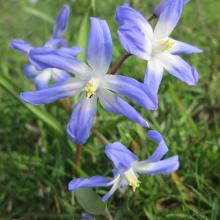Scilla luciliae
Common name:
Glory-of-the-snow
Genus:
Scilla
Family:
Asparagaceae
Order:
Asparagales
Scilla luciliae
Common name:
Glory-of-the-snow
Genus:
Scilla
Family:
Asparagaceae
Order:
Asparagales
Scilla luciliae
Common name:
Glory-of-the-snow
Genus:
Scilla
Family:
Asparagaceae
Order:
Asparagales
Genus-Plantae: Scilla
Scilla (/ˈsɪlə/) is a genus of about 30 to 80 species of bulb-forming perennial herbaceous plants in the family Asparagaceae, subfamily Scilloideae. Sometimes called the squills in English, they are native to woodlands, subalpine meadows, and seashores throughout Europe, Africa and the Middle East. A few species are also naturalized in Australasia and North America. Their flowers are usually blue, but white, pink, and purple types are known; most flower in early spring, but a few are autumn-flowering. Several Scilla species are valued as ornamental garden plants.
Taxonomy
Species of Scilla have been known since classical antiquity, being described by both Greek (Theophrastus (371–287 BC) and Discorides (40–90 AD)) and Roman (Pliny (23–79 AD) writers. Theophrastus described Scilla hyacinthoides (skilla), and more briefly S. autumnalis and S. bifolia in his Historia plantarum, where he mentions "those of squill" (σκῐ́λλης; skilles). In classical literature, Scilla was known for its medicinal properties. Later mentions include pre-Linnaen botanists such as Fuchs and Clusius, who considered many closely related plants to be types of Hyacinthus.
The genus Scilla has a long and complicated history in terms of its classification, circumscription and subdivision, and is not fully resolved. The genus Scilla was first formally described by Linnaeus in 1753, and hence bears his name as the botanical authority, Scilla L.. In Scilla, he included a six plants previously considered as Hyacinthus. For instance, he renamed Clusius' Hyacinthus stellatus cinerei coloris as Scilla italica (Hyacinthoides italica in modern systems) and Hyacinthus stellatus peruanus as Scilla peruviana, while Fuchs' Hyacinthus caeruleus mas minor, he named Scilla bifolia.
In all, Linnaeus listed eight species of Scilla, from the Mediterranean area, Europe and southwest Asia, and placed the genus in the grouping Hexandria Monogynia (6 stamens, 1 pistil) within his system of sexual classification (systema sexuale). Since he listed S. maritima (which had previously been known as scilla officinale) first this, was considered the type species. On the basis that the seed morphology distinguished this species from all the other Linnean Scilla, Steinheil reclassified it as a member of a novel genus, Urginea, now submerged in Drimia as Drimia maritima.
Later, De Jussieu (1789), using a natural system, the relative value of plant characteristics, rather than purely sexual ones, and a hierarchical system of ranks, grouped Scilla into a "family" which he called Asphodeli, along with Hyacinthus and Allium. Jaume-Saint-Hilaire (1805), while maintaining the same affiliation, recognized three species S. maritima, S. amoena and S. italica. By 1853, Lindley had created a very large order, the Liliaceae, in which Scilla and related genera formed one of eleven suborders, as Scilleae. This included many genera, including Camassia and Ornithogalum. Treatments of Scilla in the nineteenth century include those of Dumortier (1827), Salisbury (1796, 1866) and Baker (1873), with rather different approaches.
Historically, Scilla and related genera were placed with lily-like plants in the order Liliales, for instance as the tribe Hyacintheae of the family Liliaceae. The availability of molecular phylogenetic methods in taxonomic classification led to major realignments of several related monocot orders, particularly with the adoption of the Angiosperm Phylogeny Group system. Significantly, hyacinth-like plants including Scilla were initially placed in a separate family, the Hyacinthaceae in the order Asparagales, specifically in the very large subfamily Hyacinthoideae. Since 2009, the Hyacintheae, including Scilla, have been considered as Scilloideae, a subfamily of the family Asparagaceae. There they are placed as one of about 21 genera in the subtribe Hyacinthinae within tribe Hyacintheae. The most closely related genera to Scilla were Muscari Mill. and Chionodoxa Boiss.
Reference: Wikipedia

